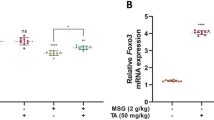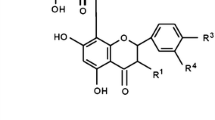Abstract
The effect of the oral administration of mimosa tannin (MMT) on the rat intra-hippocampal antioxidant ability was examined. Wistar rats at the age of 6 weeks were reared for 8 weeks with the rodent diet (RD) consisting of 0.1 g/kg of MMT (RD–MMT). The antioxidant ability of rat brain was evaluated from the decay of a brain–blood-barrier permeable stable nitroxide, 3-methoxycarbonyl-2,2,5,5-tetramethylpyrrolidine-1-oxyl (PCAM) measured by the microdialysis-electron spin resonance system under a freely moving state. The decay rate of PCAM in the brain of rats fed RD–MMT was significantly larger than that of rats fed control rodent diet, which indicates the increase of the antioxidant ability in the brain of rats fed RD–MMT. In vitro study showed that MMT did not reduce PCAM directly but enhanced the reduction of PCAM by ascorbic acid. These results indicate that MMT is a potent antioxidant in vitro and in vivo.



Similar content being viewed by others
References
Petersen OH, Spät A, Verkhratsky A (2005) Introduction: reactive oxygen species in health and disease. Phil Trans Royal Soc B Biol Sci 360:2197–2199
Castro L, Freeman BA (2001) Reactive oxygen species in human health and disease. Nutrition 17:161–165
Bors W, Michel C (2002) Chemistry of the antioxidant effect of polyphenols. Ann N Y Acad Sci 957:57–69
Lotito SB, Frei B (2004) Relevance of apple polyphenols as antioxidants in human plasma: contrasting in vitro and in vivo effects. Free Radic Biol Med 36:201–211
Perron NR, Brumaghim JL (2009) A review of the antioxidant mechanisms of polyphenol compounds related to iron binding. Cell Biochem Biophys 53:75–100
Rodrigo R, Bosco C (2006) Oxidative stress and protective effects of polyphenols: comparative studies in human and rodent kidney. A review. Comp Biochem Physiol C 142:317–327
Sutherland B, Rahman RMA, Appleton I (2006) Mechanism of action of green tea catechins, with a focus on ischemia-induced neurodegeneration. J Nutr Biochem 17:291–306
Panickar KS, Anderson RA (2011) Effect of polyphenols on oxidative stress and mitochondrial dysfuncrtion in neuronal death and brain edema in cerebral ischemia. Int J Mol Sci 12:8181–8207
Basli A, Soulet S, Chaher N, Mérillon J-M, Chibane M, Monti J-P, Richard T (2012) Wine polyphenols: potential agents in neuroprotection. Oxid Med Cell Longev ID805762:1–14
Hagerman AE, Riedl KM, Jones GA, Sovik KN, Ritchard NT, Hartzfeld PW, Riechel TL (1998) High molecular weight plant polypenolics (Tannins) as biological antioxidants. J Agric Food Chem 46:1887–1892
Tian Y, Zou B, Li C, Yang J, Xu S, Hagerman AE (2012) High molecular weight persimmon tannin is a potent antioxidant both ex vivo and in vivo. Food Res Int 45:26–30
Ueda Y, Doi T, Tokumaru J, Nakajima A, Nagatomo K (2005) In vivo evaluation of the effect of zonisamide on the hippocampal redox state during kainic acid-induced seizure status in rats. Neurochem Res 30:1117–1121
Ueda Y, Doi T, Nagatomo K, Nakajima A (2007) Protective role of pentobarbital pretreatment for NMDA-R activated lipid peroxidation is derived from the synergistic effect on endogenous anti-oxidant in the hippocampus of rats. Neurosci Lett 417:46–49
Ueda Y, Doi T, Takaki M, Nagatomo K, Nakajima A, Willmore LJ (2009) Levetiracetam enhances endogenous antioxidant in the hippocampus of rats: in vivo evaluation by brain microdialysis combined with ESR spectroscopy. Brain Res 1266:1–7
Ueda Y, Nakajima A, Oikawa T (2010) Hydrogen-related enhancement of in vivo antioxidant ability in the brain of rats fed coral calcium hydride. Neurochem Res 35:1510–1515
Nakajima A, Sakurai Y, Matsuda E, Masuda Y, Naganobu Y, Tajima K, Sameshima H, Ikenoue T (2013) Abilities of water-soluble biosubstances to eliminate hydroxyl and superoxide radicals examined by spin-trapping ESR measurements: two-dimensional presentation of antioxidant ability. Biosci Biotech Biochem 77:324–331
Nakajima A, Ueda Y, Matsuda E (2010) Effect of catechins and tannins on hydroxyl radical formation in depleted uranium-hydrogen peroxide systems. J Radioanal Nucl Chem 283:151–156
Matsuda E, Nakajima A (2012) Effect of catechins and tannins on depleted uranium-induced DNA strand breaks. J Radioanal Nucl Chem 293:711–714
Ueda Y, Yokoyama H, Tokumaru J, Doi T, Nakajima A (2004) Kinetics of extracellular nitroxide radical and glutamate levels in the hippocampus of conscious rats: cautionary note to the application of nitroxide radical on clinical arena. Neurochem Res 29:1695–1701
Rambo ON, Zboralske FF, Harris PA, Riegelman S, Margulis AR (1966) Toxicity studies on tannic acid administered by Enema. I. Effects of Enema-administered tannic acid on the colon and liver of rats. Am J Roentgenol 96:488–497
Harris PA, Zboralske FF, Rambo ON, Margulis AR, Riegelman S (1966) Toxicity studies on tannic acid administered by Enema. II. The clonic absorption and intraperitoneal toxicity of tannic acid and its hydrolytic products in rats. Am J Roentgenol 96:498–504
Sudha M, Gnanamani A, Deepa G, Sudha M, Madhavacharyulu E, Deivanai K, Sadulla S (2008) In vivo studies on evaluation of potential toxicity of unspent tannins using albino rats (Rattus norvegicus). Food Chem Toxicol 46:2288–2295
Joslyn MA, Glick Z (1969) Comparative effects of gallotannic acid and related phenolics on the growth of rats. J Nutr 98:119–126
Pellegrino JL, Pellegrino AS, Cushman AJA (1986) Stereotaxic atlas of the rat brain. Plenum Press, New York
Valko M, Leibfritz D, Moncol J, Cronin MTD, Mazur M, Telser J (2007) Free radicals and antioxidants in normal physiological functions and human disease. Int J Biochem Cell Biol 39:44–84
Acknowledgments
This work was supported by a cooperative Grant for innovative technology and advanced research in evolutional areas from the Ministry of Education, Science, Sports, and Culture of Japan.
Author information
Authors and Affiliations
Corresponding author
Rights and permissions
About this article
Cite this article
Nakajima, A., Ueda, Y., Matsuda, E. et al. Enhancement of In Vivo Antioxidant Ability in the Brain of Rats Fed Tannin. Neurochem Res 38, 1360–1364 (2013). https://doi.org/10.1007/s11064-013-1031-2
Received:
Revised:
Accepted:
Published:
Issue Date:
DOI: https://doi.org/10.1007/s11064-013-1031-2




